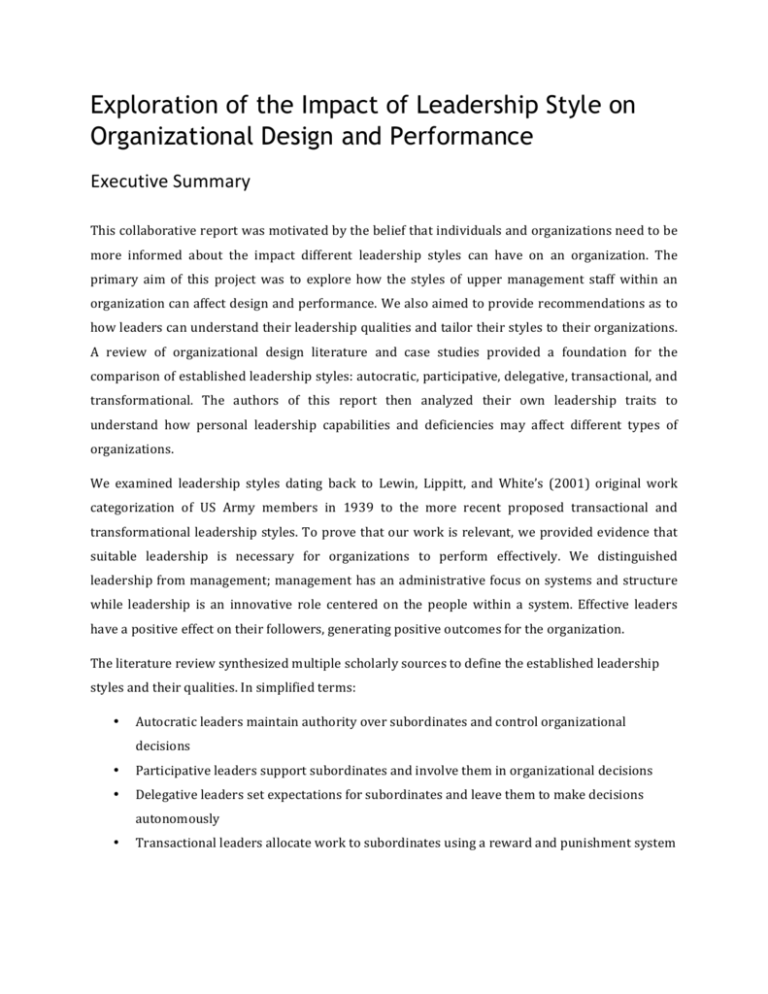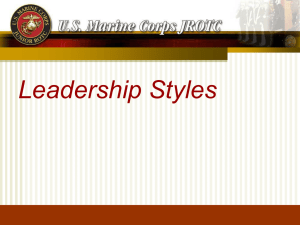8 Exploration of the Impact of Leadership Style on Organizational
advertisement

Exploration of the Impact of Leadership Style on Organizational Design and Performance Executive Summary This collaborative report was motivated by the belief that individuals and organizations need to be more informed about the impact different leadership styles can have on an organization. The primary aim of this project was to explore how the styles of upper management staff within an organization can affect design and performance. We also aimed to provide recommendations as to how leaders can understand their leadership qualities and tailor their styles to their organizations. A review of organizational design literature and case studies provided a foundation for the comparison of established leadership styles: autocratic, participative, delegative, transactional, and transformational. The authors of this report then analyzed their own leadership traits to understand how personal leadership capabilities and deficiencies may affect different types of organizations. We examined leadership styles dating back to Lewin, Lippitt, and White’s (2001) original work categorization of US Army members in 1939 to the more recent proposed transactional and transformational leadership styles. To prove that our work is relevant, we provided evidence that suitable leadership is necessary for organizations to perform effectively. We distinguished leadership from management; management has an administrative focus on systems and structure while leadership is an innovative role centered on the people within a system. Effective leaders have a positive effect on their followers, generating positive outcomes for the organization. The literature review synthesized multiple scholarly sources to define the established leadership styles and their qualities. In simplified terms: • Autocratic leaders maintain authority over subordinates and control organizational decisions • Participative leaders support subordinates and involve them in organizational decisions • Delegative leaders set expectations for subordinates and leave them to make decisions autonomously • Transactional leaders allocate work to subordinates using a reward and punishment system • Transformative leaders motivate, inspire, challenge, and recognize the unique needs of their subordinates as they incorporate transactional agreements in their future-­‐oriented visions for change There are intricacies to each style which we considered in our analysis of the benefits and disadvantages they can bring upon organizational performance. We also demonstrate the real-­‐ world application of leadership styles through CEO case studies: Bill Gates (autocratic), Carlos Ghosn (participative), Bill Gates (delegative), Alan Sugar (transactional), and Lee Iacocca (transformational). In addition to describing the various leadership styles, each group member has completed a leadership style questionnaire to identify their leadership style. This self-­‐reflection has helped each team member identify their strengths and weaknesses as leaders. In the comparison of leadership styles, we claim that organization structure, culture, values, and objectives are critical factors in determining the best-­‐fitting leadership style. Furthermore, different styles are needed to suit particular tasks within a single organization. The team’s leadership styles were analyzed. It is recommended that leadership behaviour and styles become a larger emphasis in the career development of undergraduate students. Knowing what type of leadership culture you relate to the most easily will help you determine which organization is best for you.







